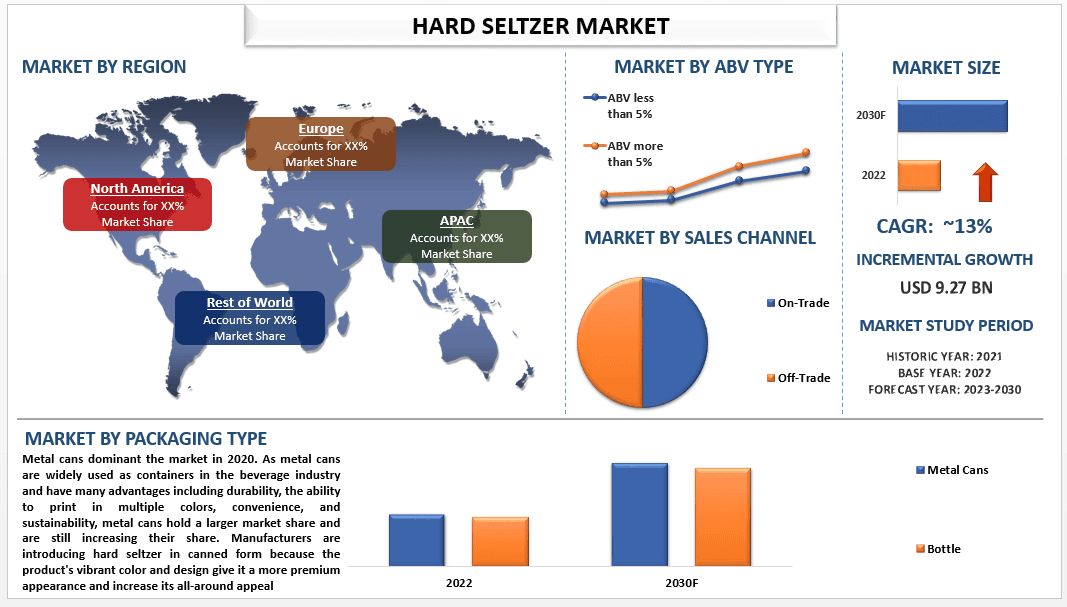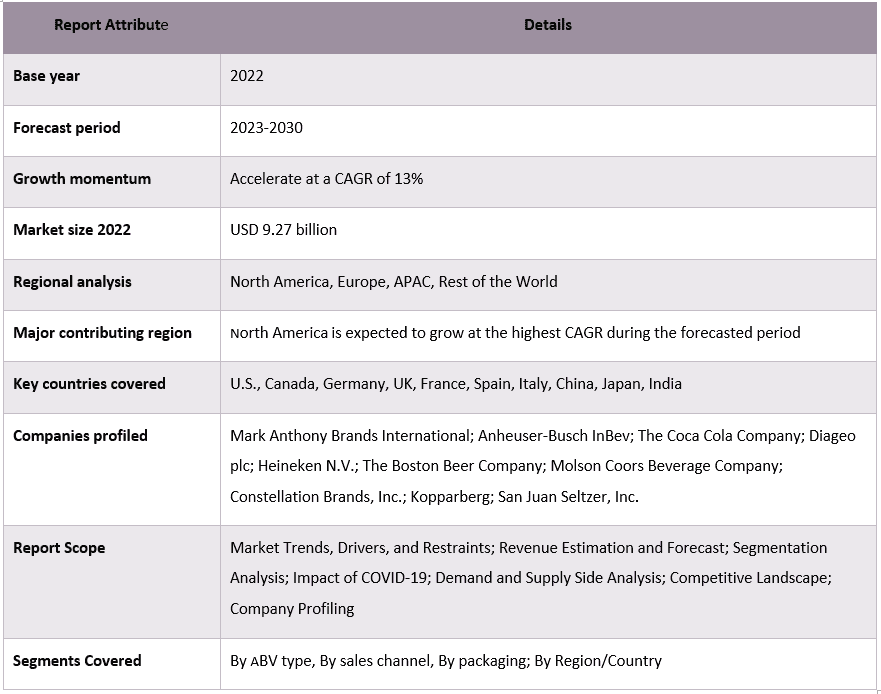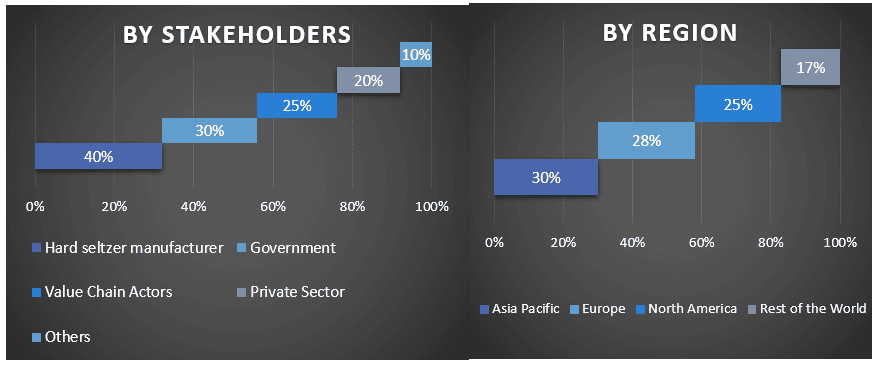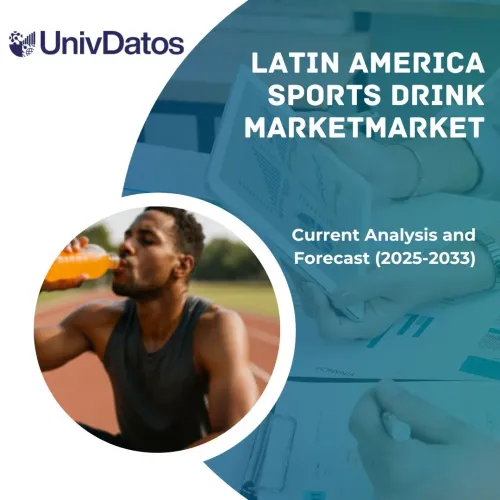- Home
- About Us
- Industry
- Services
- Reading
- Contact Us
Hard Seltzer Market: Current Analysis and Forecast (2023-2030)
Emphasis on ABV Type (ABV less than 5%, ABV more than 5%); Sales Channel (On-Trade, Off-Trade); Packaging Type (Metal Cans, Bottles); and Region/Country

The hard seltzer market is expected to grow at a steady rate of around CAGR of 13% from 2022 to 2028. Demand for hard seltzers has increased even in emerging nations as a result of altering lifestyle choices to promote health and the move toward responsible drinking. Due to the growing emphasis on health and wellbeing, there is an increase in consumer demand for non-alcoholic and low-alcohol beverages. For instance, Hard seltzer beverages come in a wide range of tastes, including orange, grapefruit, grapes, lemon, and others, and are typically high in vitamin C as a result. Additionally, the majority of these come in 350 ml cans with 85 to 110 calories per serving and no artificial sweeteners or flavours. As a result, these drinks match the health halo of many consumers who want to drink healthier beverages than beer.
Some of the major players operating in the market include Mark Anthony Brands International; Anheuser-Busch InBev; The Coca Cola Company; Diageo plc; Heineken N.V.; The Boston Beer Company; Molson Coors Beverage Company; Constellation Brands, Inc.; Kopparberg; San Juan Seltzer, Inc.
Insights Presented in the Report
“Amongst sales channel, on-trade category to witness highest CAGR during the forecast period”
Based on sales channel type, the market is segmented into On-Trade and Off-Trade. On-Trade segment is anticipated to witness highest CAGR during the forecast period due to collaborations between producers and on-trade outlets like restaurants and bars. In addition, rising customer desire for hard seltzers in on-trade stores is anticipated to fuel market expansion. The worldwide COVID-19 pandemic has caused lockdowns and closures. As a result, sales through these channels have decreased. However, because social conventions are being relaxed and more people are focusing on socializing, gatherings, and parties, product sales through on-trade platforms are probably going to rise.
“Amongst ABV type, ABV Less than 5% segment to be fastest growing in the hard seltzer market during the forecast period”
Based on ABV type, the market is segmented into ABV less than 5% and ABV more than 5%. ABV less than 5% segment to be fastest growing in the hard seltzer market during the forecast period due to Low-ABV products are expected to attract more health-conscious consumers. An increase in the number of millennials, followed by a rise in consumer preferences for beverages with low alcohol content, calories, and gluten content, an increase in the tourism and hospitality industries, a rise in consumer health consciousness, and an increase in demand for convenience are some of the key factors. For Instance, The Centers for Disease Control and Prevention estimate that 29% of high school students in the United States drank regularly in 2019. According to the 2019 National Survey on Drug Use and Health, 11% of young people between the ages of 12 and 20 who used to drink regularly binge; this number is predicted to rise further and support the market’s expansion of ABV less than 5%.
Hard Seltzer Market Report Coverage

“North America to hold significant CAGR in the hard seltzer market.”
North America dominant market share in 2020. The main drivers of the expansion of the North American hard seltzer market are the rising young populations in countries with economies like the United States, Canada, and Mexico. The growth of the North American Hard Seltzer Market is further supported by rising initiatives from the government and NGOs to raise public awareness about excessive consumption and the negative effects of carbonated beverages and soda drinks. Companies are introducing new flavors in the market to rise its share in the region. For Instance, in March 2021, Stewarts Enterprises introduced Stewart’s Spiked Seltzer, a brand of low-calorie hard seltzers in three flavors—Root Beer, Orange Cream, and Black Cherry in order to grow in the northeastern United States.
Reasons to buy this report:
- The study includes market sizing and forecasting analysis validated by authenticated key industry experts.
- The report presents a quick review of overall industry performance at one glance.
- The report covers an in-depth analysis of prominent industry peers with a primary focus on key business financials, product portfolio, expansion strategies, and recent developments.
- Detailed examination of drivers, restraints, key trends, and opportunities prevailing in the industry.
- The study comprehensively covers the market across different segments.
- Deep dive regional level analysis of the industry.
Customization Options:
The global hard seltzer market can further be customized as per the requirement or any other market segment. Besides this, UMI understands that you may have your own business needs, hence feel free to connect with us to get a report that completely suits your requirements.
Table of Content
Research Methodology for the Hard Seltzer Market Analysis (2022-2030)
Analyzing the historical market, estimating the current market, and forecasting the future market of the global hard seltzer market were the three major steps undertaken to create and analyze the adoption of hard seltzer market in major regions globally. Exhaustive secondary research was conducted to collect the historical market numbers and estimate the current market size. Secondly, to validate these insights, numerous findings and assumptions were taken into consideration. Moreover, exhaustive primary interviews were also conducted, with industry experts across the value chain of the global hard seltzer market. Post assumption and validation of market numbers through primary interviews, we employed a top-down/bottom-up approach to forecasting the complete market size. Thereafter, market breakdown and data triangulation methods were adopted to estimate and analyze the market size of segments and sub-segments of the industry pertains to. Detailed methodology is explained below:
Analysis of Historical Market Size
Step 1: In-Depth Study of Secondary Sources:
Detail secondary study was conducted to obtain the historical market size of the hard seltzer market through company internal sources such as annual reports & financial statements, performance presentations, press releases, etc., and external sources including journals, news & articles, government publications, competitor publications, sector reports, third-party database, and other credible publications.
Step 2: Market Segmentation:
After obtaining the historical market size of the hard seltzer market, we conducted a detailed secondary analysis to gather historical market insights and share for different segments & sub-segments for major regions. Major segments are included in the report as ABV type, sales channel, and packaging type. Further country-level analyses were conducted to evaluate the overall adoption of testing models in that region.
Step 3: Factor Analysis:
After acquiring the historical market size of different segments and sub-segments, we conducted a detailed factor analysis to estimate the current market size of the hard seltzer market. Further, we conducted factor analysis using dependent and independent variables such as ABV type, sales channel type, and packaging type of hard seltzer market. A thorough analysis was conducted for demand and supply-side scenarios considering top partnerships, mergers and acquisitions, business expansion, and product launches in the hard seltzer market sector across the globe.
Current Market Size Estimate & Forecast
Current Market Sizing: Based on actionable insights from the above 3 steps, we arrived at the current market size, key players in the global hard seltzer market, and market shares of the segments. All the required percentage shares split, and market breakdowns were determined using the above-mentioned secondary approach and were verified through primary interviews.
Estimation & Forecasting: For market estimation and forecast, weights were assigned to different factors including drivers & trends, restraints, and opportunities available for the stakeholders. After analyzing these factors, relevant forecasting techniques i.e., the top-down/bottom-up approach were applied to arrive at the market forecast for 2028 for different segments and sub-segments across the major markets globally. The research methodology adopted to estimate the market size encompasses:
- The industry’s market size, in terms of revenue (USD) and the adoption rate of the hard seltzer market across the major markets domestically
- All percentage shares, splits, and breakdowns of market segments and sub-segments
- Key players in the global hard seltzer market in terms of products offered. Also, the growth strategies adopted by these players to compete in the fast-growing market
Market Size and Share Validation
Primary Research: In-depth interviews were conducted with the Key Opinion Leaders (KOLs) including Top Level Executives (CXO/VPs, Sales Head, Marketing Head, Operational Head, Regional Head, Country Head, etc.) across major regions. Primary research findings were then summarized, and statistical analysis was performed to prove the stated hypothesis. Inputs from primary research were consolidated with secondary findings, hence turning information into actionable insights.
Split of Primary Participants in Different Regions

Market Engineering
The data triangulation technique was employed to complete the overall market estimation and to arrive at precise statistical numbers for each segment and sub-segment of the global hard seltzer market. Data was split into several segments & sub-segments post studying various parameters and trends in the areas of product type, sales channel, and end user type in the global hard seltzer market.
The main objective of the global hard seltzer market study
The current & future market trends of the global hard seltzer market were pinpointed in the study. Investors can gain strategic insights to base their discretion for investments on the qualitative and quantitative analysis performed in the study. Current and future market trends determined the overall attractiveness of the market at a regional level, providing a platform for the industrial participant to exploit the untapped market to benefit from a first-mover advantage. Other quantitative goals of the studies include:
- Analyze the current and forecast market size of the hard seltzer market in terms of value (USD). Also, analyze the current and forecast market size of different segments and sub-segments
- Segments in the study include areas ABV type, sales channel, and packaging type.
- Define and analysis of the regulatory framework for the hard seltzer
- Analyze the value chain involved with the presence of various intermediaries, along with analyzing customer and competitor behaviors of the industry.
- Analyze the current and forecast market size of the hard seltzer market for the major region.
- Major countries of regions studied in the report include Asia Pacific, Europe, North America, and the Rest of the World.
- Company profiles of the hard seltzer market and the growth strategies adopted by the market players to sustain in the fast-growing market
- Deep dive regional level analysis of the industry
Frequently Asked Questions FAQs
Q1: What is the current market size and growth potential of the global hard seltzer market?
Q2: What are the driving factors for the growth of the global hard seltzer market?
Q3: Which segment has the largest share of the global hard seltzer market by ABV type?
Q4: What are the emerging opportunities in the global hard seltzer market?
Q5: Which region will dominate the global hard seltzer market?
Q6: Who are the key players operating in the global hard seltzer market?
Related Reports
Customers who bought this item also bought










